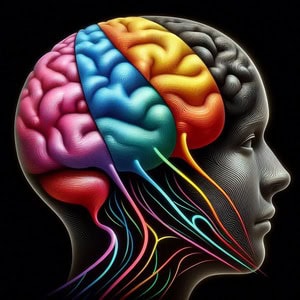Mysteries of mind has ever been an interesting topic for the human race. Have you ever found yourself wondering how our brains work? Or why different people behave differently in similar situations? These questions have fascinated humans for centuries, and today, we’re going to dive deep into the fascinating world of neuroscience and Neuro-Linguistic Programming (NLP) to uncover some answers.
The Evolving Human Brain
Our journey begins with a remarkable fact: over the past 600 million years, the human brain has tripled in size. This dramatic evolution wasn’t just about getting bigger; it was about becoming more efficient at processing the vast amount of information we encounter daily.
But how exactly does our brain handle all this data? Let’s break it down.
The Five Senses: Our Gateway to the World
Our brain receives information through five primary senses:
1. Eyes (visual information)
2. Ears (auditory information)
3. Nose (olfactory information)
4. Tongue (taste information)
5. Skin (touch and feeling)
Here’s where things get interesting: our brain receives a staggering 400 million bits of information per second through these senses. However, it can only consciously process about 2,000 bits per second. This discrepancy leads us to a fascinating question: how does our brain decide what information to focus on?
The Brain’s Filtering System
To manage this flood of data, our brain employs a sophisticated filtering system. This system consists of three primary filters:
1. **Deletion**: This filter helps us focus on what’s important by “deleting” or ignoring irrelevant information. For example, when you’re engrossed in a conversation, you might not notice background noises or other distractions.
2. **Distortion**: This filter alters information to fit our existing beliefs and expectations. It’s like reading a summary instead of a full report – you get the gist, but some details might be changed or omitted.
3. **Generalization**: This filter helps us make quick decisions based on past experiences. If we encounter a situation similar to one we’ve faced before, our brain generalizes and applies the same response.
These filters are crucial for our survival and efficiency, but they also explain why different people can perceive the same situation in vastly different ways.
The Role of Personal Internal Representation (PIR)
When an event occurs in the external world (let’s call it E1), it passes through our brain’s filtering system. What emerges on the other side is our Personal Internal Representation (PIR) of that event (let’s call this E2).
E1 (External Event) → Filtering System → E2 (Personal Internal Representation)
This process explains why two people can witness the same event but have completely different reactions. Their unique filters, shaped by past experiences, beliefs, and values, create distinct internal representations of the same external reality.
The Subconscious Mind: Our Silent Director
Behind the scenes of this entire process is our subconscious mind and the mysteries of mind . This powerful part of our psyche operates on two fundamental principles:
1. Avoiding pain
2. Seeking pleasure
These drives, rooted in our evolutionary past, continue to shape our behavior today. Our subconscious mind is constantly working to keep us safe and guide us towards experiences it believes will bring us happiness and fulfillment.
Applying NLP to Understand and Improve Brain Function
Now that we understand these basic principles of how our brain processes information and the mysteries of mind , we can explore how Neuro-Linguistic Programming (NLP) can help us harness this knowledge for personal growth and improved communication.
NLP is a powerful tool that allows us to:
1. **Become aware of our filters**: By recognizing our personal biases and tendencies, we can start to understand why we react the way we do in certain situations.
2. **Challenge our generalizations**: NLP techniques can help us question and update unhelpful generalizations that may be limiting our potential.
3. **Reframe our internal representations**: By consciously changing how we represent events internally, we can alter our emotional responses and behaviors.
4. **Communicate more effectively**: Understanding that others have different filters helps us tailor our communication to be more persuasive and empathetic.
5. **Reprogram our subconscious mind**: NLP provides tools to align our subconscious drives with our conscious goals, leading to more consistent and positive behaviors.
Practical Applications of NLP in Daily Life
Let’s explore some ways you can apply these NLP principles in your everyday life:
1. **Mindful Observation**: Pay attention to your automatic reactions in different situations. Are there patterns in how you filter information? This awareness is the first step to making positive changes.
2. **Challenging Assumptions**: When you find yourself making a generalization, pause and ask, “Is this always true? Are there exceptions?” This simple practice can open up new possibilities and perspectives.
3. **Reframing Negative Experiences**: When something unpleasant happens, try to find a positive angle or lesson. This doesn’t mean ignoring negative emotions, but rather finding constructive ways to process them.
4. **Empathetic Communication**: Remember that others are filtering information differently than you. Try to understand their perspective and adapt your communication style accordingly.
5. **Visualization Techniques**: Use the power of your imagination to create positive internal representations of your goals and desired outcomes. This can help program your subconscious mind for success.
The Path Forward: Continuous Learning and Growth
Understanding the mysteries of mind and how our brain works is an ongoing journey. As we continue to learn more about neuroscience and refine NLP techniques, we unlock new potentials for personal development and improved interpersonal relationships.
Remember, the goal isn’t to completely rewire your brain or change who you are fundamentally. Instead, it’s about becoming more aware of your mental processes and learning to work with them more effectively and not let it be the mysteries of mind anymore . By doing so, you can make more conscious choices, react more constructively to life’s challenges, and ultimately lead a more fulfilling life.
As you continue on this path of self-discovery and growth, keep an open mind and be patient with yourself. Change doesn’t happen overnight, but with consistent practice and a willingness to learn, you can gradually reshape your patterns of thinking and behaving.
In conclusion, the human brain is an incredible organ, capable of processing vast amounts of information and adapting to countless situations. By understanding its workings through the lens of NLP, we gain valuable insights into our behaviors and thought patterns. This knowledge empowers us to take control of our personal growth, improve our relationships, and navigate life’s complexities with greater ease and confidence.
So, the next time you find yourself wondering about the mysteries of mind, remember that you have the power to shape your own mental landscape. Embrace the journey of self-discovery, and watch as your understanding of yourself and others transforms your life in remarkable ways.
Mysteries of mind is a ever mysterious subject and a complex process.



1 thought on “Mysteries of Mind: How NLP Helps Us Understand Brain Function”